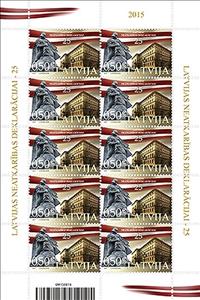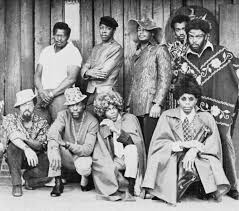Mini Sheet: 25th Anniversary of Latvia’s Declaration of Independence (Latvia 2015)
25th Anniversary of Latvia’s Declaration of Independence (Latvia 2015)
29 April (Latvia ) within release 25th Anniversary of Latvia’s Declaration of Independence goes into circulation Mini Sheet 25th Anniversary of Latvia’s Declaration of Independence face value 10*0.50 Euro
| Mini Sheet 25th Anniversary of Latvia’s Declaration of Independence in catalogues | |
|---|---|
| AFA number: | AFA:LV A951 |
| Michel: | Mi:LV 944KB |
Mini Sheet is square format.
Also in the issue 25th Anniversary of Latvia’s Declaration of Independence:
- Stamp - 25th Anniversary of Latvia’s Declaration of Independence face value 0.50;
- Mini Sheet - 25th Anniversary of Latvia’s Declaration of Independence face value 10*0.50;
Mini Sheet 25th Anniversary of Latvia’s Declaration of Independence it reflects the thematic directions:
Special Occasions
A flag is a piece of fabric (most often rectangular or quadrilateral) with a distinctive design that is used as a symbol, as a signaling device, or as decoration. The term flag is also used to refer to the graphic design employed, and flags have since evolved into a general tool for rudimentary signalling and identification, especially in environments where communication is similarly challenging (such as the maritime environment where semaphore is used). National flags are patriotic symbols with varied wide-ranging interpretations, often including strong military associations due to their original and ongoing military uses. Flags are also used in messaging, advertising, or for other decorative purposes. The study of flags is known as vexillology, from the Latin word vexillum, meaning flag or banner.
A monument is a type of structure that was explicitly created to commemorate a person or event, or which has become relevant to a social group as a part of their remembrance of historic times or cultural heritage, due to its artistic, historical, political, technical or architectural importance. Examples of monuments include statues, (war) memorials, historical buildings, archaeological sites, and cultural assets. If there is a public interest in its preservation, a monument can for example be listed as a UNESCO World Heritage Site. The Palgrave Encyclopedia of Cultural Heritage and Conflict gives the next definition of monument:
In modern politics, and history, a parliament is a legislative body of government. Generally, a modern parliament has three functions: representing the electorate, making laws, and overseeing the government via hearings and inquiries. The term is similar to the idea of a senate, synod or congress and is commonly used in countries that are current or former monarchies. Some contexts restrict the use of the word parliament to parliamentary systems, although it is also used to describe the legislature in some presidential systems (e.g., the Parliament of Ghana), even where it is not in the official name.
A building or edifice is a structure with a roof and walls standing more or less permanently in one place, such as a house or factory. Buildings come in a variety of sizes, shapes and functions, and have been adapted throughout history for a wide number of factors, from building materials available, to weather conditions, to land prices, ground conditions, specific uses and aesthetic reasons. Buildings serve several needs of society – primarily as shelter from weather, security, living space, privacy, to store belongings, and to comfortably live and work. A building as a shelter represents a physical division of the human habitat (a place of comfort and safety) and the outside (a place that at times may be harsh and harmful).





